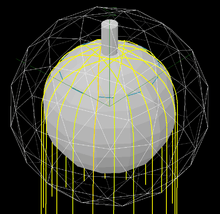SNO+

SNO+ is an underground physics experiment under construction (as of 2014) that makes use of the equipment already installed underground for the former Sudbury Neutrino Observatory (SNO) experiment at SNOLAB. The main goals of the project are a search for neutrinoless double beta decay, the measurement of proton–electron–proton (pep) solar neutrinos, geoneutrinos from radioactive decays in the Earth, and reactor neutrinos. It will also be possible to observe supernovae neutrinos if one occurs in our galaxy.
Testing and construction
Testing (filled with water) is expected to begin in mid-2014, with full operation with liquid scintillator in 2015.[1] In order to reach these goals, linear alkyl benzene will be used as a liquid scintillator and target material.[2] Measurement of neutrinoless double beta decay will also be made by adding 130Te to the scintillator.
A mass of many tons of double beta decaying material could be added to the experiment. This would make SNO+ the largest experiment to study neutrinoless double beta decay. A neutrino interaction with this liquid produces several times more light than an interaction in a water Cherenkov experiment such as the original SNO experiment or Super-Kamiokande. The energy threshold for the detection of neutrinos therefore can be lower, and proton–electron–proton solar neutrinos (with an energy of 1.44 MeV) can be observed. In addition, a liquid scintillator experiment can detect anti-neutrinos like those created in nuclear fission reactors and the decay of thorium and uranium in the earth.
The project received funding for initial construction from NSERC in April 2007, and as of early 2013, the cavity has been refurbished and re-sealed to the new cleanliness standards, which are (due to the experiment's greater sensitivity) more stringent than for the original SNO.
The main engineering challenge is that the current SNO vessel is supported by a series of ropes, to prevent the weight of the heavy water inside from sinking it in the surrounding normal water. The proposed liquid scintillator (linear alkyl benzene) is lighter than water, and must be held down instead, but still without blocking the view of its interior. The existing support rope attachment points, cast into the acrylic sphere's equator, are not suitable for upside-down use.
Computing
The collaboration is investigating the use of grid resources to deliver the computing power needed by the experiment. This is after the success of the LHC Computing Grid (wLCG) used by the LHC experiments. The SNO+ VO has been using resources provided by GridPP.[3]
References
- ↑ Hartnell, J. (8 April 2014). "Neutrino Mass Searches with Beta Decay Experiments" (PDF). IOP 2014 Joint HEPP and APP Groups Meeting. Institute of Physics. Slide 36.
|chapter=ignored (help) - ↑ Lasserre, T.; Fechner, M.; Mention, G.; Reboulleau, R.; Cribier, M.; Letourneau, A.; Lhuillier, D. (2010). "SNIF: A Futuristic Neutrino Probe for Undeclared Nuclear Fission Reactors". arXiv:1011.3850 [nucl-ex].
- ↑ "Grid Computing". SNO+. Retrieved 2014-08-05.
Further reading
External links
| ||||||||||||||||||||||||||||||